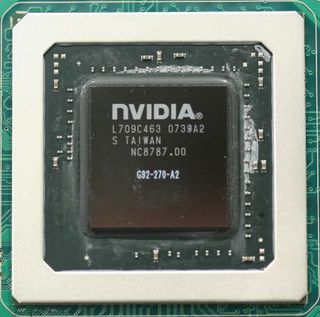Nvidia's GeForce 8800 GTS 512 MB
Specifications
There's actually little to know about the GeForce 8800 GTS 512 Mo. It takes back the G92 chip introduced with the renowned 8800 GT, but in a boosted version as it maintains the 128 stream processors of the 8800 GTX. It confirms, by the way, that the G92 isn't limited to the 112 stream processors activated on the 8800 GT. That's not all since clock wise we now see 650 MHz for the GPU and 1625 MHz for the shaders, which is another increase compared to the 8800 GT. Basically, the latter had made the GeForce 8800 GTS 320 MB and 640 MB obsolete and this new 8800 GTS 512 MB brings shame, at least on paper, to the 8800 GTX (17% less efficient) and the 8800 Ultra as well (7% less efficient)!
| Main cards' specifications | ||||
|---|---|---|---|---|
| GPU | 8800 GTS 640 | 8800 GT 512 | 8800 GTS 512 | 8800 GTX |
| GPU Clock | 500 MHz | 600 MHz | 650 MHz | 575 MHz |
| Shaders Clock | 1200 MHz | 1500 MHz | 1625 MHz | 1350 MHz |
| Memory Clock | 800 MHz | 900 MHz | 970 MHz | 900 MHz |
| Width of the Memory Bus | 320 bits | 256 bits | 256 bits | 384 bits |
| Memory type | GDDR3 | GDDR3 | GDDR3 | GDDR3 |
| Memory Capacity | 640 MB | 512 MB | 512 MB | 768 MB |
| Number of Pixels/Vertex Pipelines | (24) | (28) | (32) | (32) |
| Number of texturing units | 24 | 56 | 56 | 32 |
| Number of ROP | 20 | 16 | 16 | 24 |
| Throughput | 230.4 GFlops | 336 GFlops | 416 GFlops | 346 GFlops |
| Memory bandwidth | 64 GB/s | 57.6 GB/s | 62.1 GB/s | 86.4 GB/s |
| Number of transistors | 681 millions | 754 millions | 754 millions | 681 millions |
| Process | 0.09µ TSMC | 0.065µ TSMC | 0.065µ TSMC | 0.09µ TSMC |
| Die's surface | 484 mm² | 324 mm² | 324 mm² | 484 mm² |
| Generation | 2007 | 2007 | 2007 | 2006 |
| PureVideo | 1 | 2 | 2 | 1 |

The G92 strikes back, more powerful than ever
Of course, once again memory becomes the decider. On the one hand we have capacity; because the GTX is still equipped with 768 MB whereas the new 8800 GTS comes with only 512 MB Compare Prices on 512 MB GeForce 8800 GTS Video Cards , which is less than the 640 MB of the previous version. On the other hand we have the bandwidth. When the chip's clock reaches 970 MHz it allows it to be on par with the previous 8800 GTS despite the 256 bits bus limitation. The GTX also displays a "third lung" which gives it 39% more bandwidth. Let's see what this means practically.
Stay on the Cutting Edge
Join the experts who read Tom's Hardware for the inside track on enthusiast PC tech news — and have for over 25 years. We'll send breaking news and in-depth reviews of CPUs, GPUs, AI, maker hardware and more straight to your inbox.
Current page: Specifications
Prev Page Introduction Next Page Sparkle And Gigabyte Cards, The Review-
eisley Hi, this is a tricky question, I think. I'm curious. How come a 5 year old video card is only 9 tiers down below the more recent and super powerful 7970 GHz Ed.? (From your most recent Graphics Card Hierarchy Chart) And also it is 8 tiers above the pretty cool Intel HD Graphics 4000?Reply
Does that mean its specs and 512 MB are enough to work with media and play nicely most nowadays games? (at medium-high settings?) I know that does not only depend on the video card, but that chart suggest that.
This can be silly, but I'm looking for a video card like this one. I have a Core 2 Duo E8400 3Ghz/4Gb/IntelQ45 machine that I'd like to improve by adding this video card. Any piece of advice? I'd appreciate it very much. (I know I can try upgrading to some Core 2 Quad, but I'm not to much into games nor editing).
Mostly, what I'd like, besides casual medium-high settings gamming, is what I see in my monitor (videos, images, Windows 7 user interface) is crisp and clear, -much- more than usual. I like high-definition views :)
Please, advice me on that matter. Thank you for your review. That video card looks like it's amazing. And is not that expensive.
- Leo.
(Cheers from Peru!)
Pd: My pc is an original HP Compaq dc7900 Convertible Minitower PC. And my monitor is a Full HD TV (LG LD650) I have another 3D one, and use this one for my comp. And, I'd like the video card to have an HDMI port to conect through it this monitor I use. DVI does the same? Btw.
-
eisley I think I should have said "my monitor will be a Full HD TV (LG LD650)." I couldn't get it to work with my pc cause I need a cable. Which I thought I had. I'll write more details soon. Going to reply the other post. Thanks. ^^Reply
Most Popular

